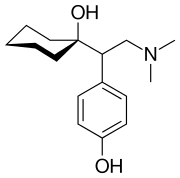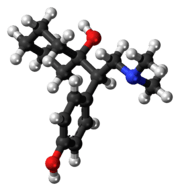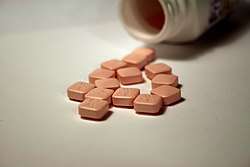Desvenlafaxine
Desvenlafaxine, sold under the brand name Pristiq among others, is a medication used to treat major depressive disorder.[1] It is recommended that the need for further treatment be occasionally reassessed.[1] It appears less effective than its parent compound venlafaxine.[2] It is taken by mouth.[1]
 | |
 | |
| Clinical data | |
|---|---|
| Trade names | Pristiq, Desfax, Ellefore, others |
| Other names | O-desmethylvenlafaxine |
| AHFS/Drugs.com | Monograph |
| MedlinePlus | a608022 |
| License data |
|
| Pregnancy category | |
| Routes of administration | By mouth |
| ATC code | |
| Legal status | |
| Legal status | |
| Pharmacokinetic data | |
| Bioavailability | 80% |
| Protein binding | Low (30%) |
| Metabolism | CYP3A4, (CYP2D6 is not involved) |
| Elimination half-life | 11 h |
| Excretion | 45% excreted unchanged in urine |
| Identifiers | |
IUPAC name
| |
| CAS Number | |
| PubChem CID | |
| IUPHAR/BPS | |
| DrugBank | |
| ChemSpider | |
| UNII | |
| KEGG | |
| ChEBI | |
| ChEMBL | |
| ECHA InfoCard | 100.149.615 |
| Chemical and physical data | |
| Formula | C16H25NO2 |
| Molar mass | 263.38 g/mol g·mol−1 |
| 3D model (JSmol) | |
SMILES
| |
InChI
| |
| | |
Common side effects include dizziness, trouble sleeping, increased sweating, constipation, sleepiness, anxiety, and sexual problems.[1] Serious side effects may include suicide in those under the age of 25, serotonin syndrome, bleeding, mania, and high blood pressure.[1] A withdrawal syndrome may occur if the dose is rapidly decreased.[1] It is unclear if use during pregnancy or breastfeeding is safe.[3] It is an antidepressant of the serotonin-norepinephrine reuptake inhibitor (SNRI) class.[1]
Desvenlafaxine was approved for medical use in the United States in 2008.[1] Use in Europe was declined in 2009.[2] In the United States the wholesale cost is about 25.20 USD per month.[4] In 2016, it was the 272nd most prescribed medication in the United States, with more than a million prescriptions.[5]
Medical uses
Desvenlafaxine is primarily used as a treatment for major depressive disorder.[6] Use has only been studied up to 8 weeks.[1] It may be less effective than venlafaxine,[2] although some studies have found comparable efficacy with a lower rate of nausea.[7]
Doses of 50-400 mg/day appear effective for major depressive disorder, although no additional benefit was demonstrated at doses greater than 50 mg/day, and adverse events and discontinuations were more frequent at higher doses.[8]
Desvenlafaxine improves the HAM-D17 score[9] and measures of well being such as the Sheehan Disability Scale (SDS) and 5-item World Health Organization Well-Being Index (WHO-5).[10]
Adverse effects
Frequency of adverse effects:[6][11][12]
Very common adverse effects include:
- Nausea
- Headache
- Dizziness
- Dry mouth
- Hyperhidrosis
- Diarrhea
- Insomnia
- Constipation
- Fatigue
Common adverse effects include:
- Tremor
- Blurred vision
- Mydriasis
- Decreased appetite
- Sexual dysfunction
- Insomnia
- Anxiety
- Elevated cholesterol and triglycerides
- Proteinuria
- Vertigo
- Feeling jittery
- Asthenia
- Nervousness
- Hot flush
- Irritability
- Abnormal dreams
- Urinary hesitation
- Yawning
- Rash
Uncommon adverse effects include:
- Hypersensitivity
- Syncope
- Depersonalization
- Hypomania
- Withdrawal syndrome
- Urinary retention
- Epistaxis (nose bleed)
- Alopecia (hair loss)
- Orthostatic hypotension
- Peripheral coldness
Rare adverse effects include:
- Hyponatraemia (low blood sodium)
- Seizures
- Extrapyramidal side effects
- Hallucinations
- Angioedema
- Photosensitivity reaction
- Stevens-Johnson syndrome
Common however unknown intensity of adverse effects include:
- Abnormal bleeding (gastrointestinal bleeds)
- Narrow-angle glaucoma
- Mania
- Interstitial lung disease
- Eosinophilic pneumonia
- Hypertension
- Suicidal behavior and thoughts
- Serotonin syndrome
Pharmacology
Desvenlafaxine is a synthetic form of the isolated major active metabolite of venlafaxine, and is categorized as a serotonin-norepinephrine reuptake inhibitor (SNRI). When most normal metabolizers take venlafaxine, approximately 70% of the dose is metabolized into desvenlafaxine, so the effects of the two drugs are expected to be very similar.[13] It works by blocking the "reuptake" transporters for key neurotransmitters affecting mood, thereby leaving more active neurotransmitters in the synapse. The neurotransmitters affected are serotonin (5-hydroxytryptamine) and norepinephrine (noradrenaline). It is approximately 10 times more potent at inhibiting serotonin uptake than norepinephrine uptake.[14]
| Transporter | Ki[nM][14][15] | IC50 [nM][14] |
|---|---|---|
| SERT | 40.2 | 47.3 |
| NET | 558.4 | 531.3 |
Approval status
United States

Wyeth announced on 23 January 2007 that it received an approvable letter from the Food and Drug Administration for desvenlafaxine. Final approval to sell the drug was contingent on a number of things, including:
- A satisfactory FDA inspection of Wyeth's Guayama, Puerto Rico facility, where the drug is to be manufactured;
- Several postmarketing surveillance commitments, and follow-up studies on low-dose use, relapse, and use in children;
- Clarity by Wyeth around the company's product education plan for physicians and patients;
- Approval of desvenlafaxine's proprietary name, Pristiq.[16]
The FDA approved the drug for antidepressant use in February 2008, and was to be available in US pharmacies in May 2008.[17]
In March 2017, the generic form of the drug was made available in the US.
Canada
On February 4, 2009, Health Canada approved use of desvenlafaxine for treatment of depression.[18][19]
European Union
In 2009, an application to market desvenlafaxine for major depressive disorder in the European Union was declined.[2] In 2012, Pfizer received authorization in Spain to market desvenlafaxine for the disorder but it is not being sold.[20][21]
Australia
Desvenlafaxine is classified as a schedule 4 (prescription only) drug in Australia. It was listed on the PBS (Pharmaceutical Benefits Scheme) in 2008 for the treatment of major depressive disorders.
See also
References
- "Desvenlafaxine Succinate Monograph for Professionals". Drugs.com. American Society of Health-System Pharmacists. Retrieved 18 March 2019.
- "Withdrawal Assessment Report for Dessvenlafaxime" (PDF). EMA. p. 3. Retrieved 22 March 2019.
- "Desvenlafaxine Pregnancy and Breastfeeding Warnings". Drugs.com. Retrieved 19 March 2019.
- "NADAC as of 2019-02-27". Centers for Medicare and Medicaid Services. Retrieved 3 March 2019.
- "The Top 300 of 2019". clincalc.com. Retrieved 22 December 2018.
- "PRODUCT INFORMATION PRISTIQ® desvenlafaxine (as succinate)" (PDF). TGA eBusiness Services. Pfizer Australia Pty Ltd. 10 December 2012. Retrieved 8 November 2013.
- Coleman, Kristina A.; Xavier, Vanessa Y.; Palmer, Trish L.; Meaney, James V.; Radalj, Libby M.; Canny, Louise M. (2012). "An indirect comparison of the efficacy and safety of desvenlafaxine and venlafaxine using placebo as the common comparator". CNS Spectrums. 17 (3): 131–141. doi:10.1017/S1092852912000648. ISSN 2165-6509. Retrieved 2019-11-06.
- Perry, Richard; Cassagnol, Manouchkathe (2009). "Desvenlafaxine: a new serotonin-norepinephrine reuptake inhibitor for the treatment of adults with major depressive disorder". Clinical Therapeutics. 31 Pt 1: 1374–1404. doi:10.1016/j.clinthera.2009.07.012. ISSN 1879-114X. PMID 19698900.
- Thase ME, Kornstein SG, Germain JM, Jiang Q, Guico-Pabia C, Ninan PT (March 2009). "An integrated analysis of the efficacy of desvenlafaxine compared with placebo in patients with major depressive disorder". CNS Spectr. 14 (3): 144–54. PMID 19407711.
- Soares CN, Kornstein SG, Thase ME, Jiang Q, Guico-Pabia CJ (October 2009). "Assessing the efficacy of desvenlafaxine for improving functioning and well-being outcome measures in patients with major depressive disorder: a pooled analysis of 9 double-blind, placebo-controlled, 8-week clinical trials". J Clin Psychiatry. 70 (10): 1365–71. doi:10.4088/JCP.09m05133blu. PMID 19906341.
- "DESVENLAFAXINE tablet, extended release [Ranbaxy Pharmaceuticals Inc.]". DailyMed. Ranbaxy Pharmaceuticals Inc. March 2013. Retrieved 9 November 2013.
- "desvenlafaxine (Rx) - Pristiq, Khedezla". Medscape Reference. WebMD. Retrieved 9 November 2013.
- Lemke, Thomas L.; Williams, David A. (2012). Foye's Principles of Medicinal Chemistry. Lippincott Williams & Wilkins. p. 609. ISBN 978-1-60913-345-0.
- Deecher, DC; Beyer, CE; Johnston, G; Bray, J; Shah, S; Abou-Gharbia, M; Andree, TH (August 2006). "Desvenlafaxine succinate: A new serotonin and norepinephrine reuptake inhibitor" (PDF). The Journal of Pharmacology and Experimental Therapeutics. 318 (2): 657–665. doi:10.1124/jpet.106.103382. PMID 16675639.
- Roth, BL; Driscol, J (Dec 2012). "PDSP Ki Database". Psychoactive Drug Screening Program (PDSP). University of North Carolina at Chapel Hill and the United States National Institute of Mental Health. Retrieved 7 July 2018.
- "Wyeth Receives Approvable Letter From FDA For Pristiq (Desvenlafaxine Succinate) For The Treatment Of Major Depressive Disorder" (Press release). 2007-01-23. Retrieved 2007-04-04.
- "FDA Approves Pristiq" (Press release). Wyeth. 2008-02-29. Archived from the original on 2008-03-05. Retrieved 2008-02-29.
- Health Canada Notice of Compliance - Pristiq. February 4, 2009, retrieved on March 9, 2009.
- "Summary Basis of Decision (SBD) PrPristiq™". Health Canada. 2009-05-29. Archived from the original on 2016-10-18. Retrieved 2016-12-30.
- "Pristiq 100 mg Comprimidos de Liberacion Prolongada". AEMPS Medicines Online Information Center - CIMA. Retrieved 2016-12-30.
- "Pristiq 50 mg Comprimidos de Liberacion Prolongada". AEMPS Medicines Online Information Center - CIMA. Retrieved 2016-12-30.